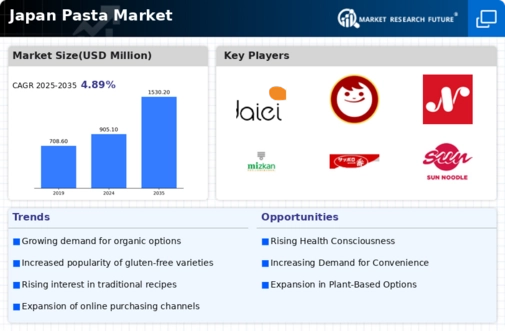Innovations in Pasta Production
Innovations in pasta production technology are likely to play a crucial role in shaping the pasta market in Japan. Advances such as the development of gluten-free and high-protein pasta options cater to the growing demand for healthier alternatives. Recent statistics suggest that gluten-free pasta sales have increased by 30% in the past year, indicating a shift in consumer preferences towards dietary inclusivity. Additionally, the introduction of new flavors and shapes may appeal to younger demographics, enhancing the overall appeal of pasta products. As manufacturers continue to innovate, the pasta market is expected to evolve, attracting a broader consumer base.
Cultural Integration and Culinary Trends
Cultural integration and evolving culinary trends are influencing the pasta market in Japan. The fusion of traditional Japanese flavors with Italian pasta dishes is becoming increasingly popular, as chefs experiment with unique combinations. This trend is reflected in the growing number of restaurants offering innovative pasta dishes that incorporate local ingredients, such as miso or seaweed. Market analysis indicates that fusion pasta dishes have seen a rise in popularity, with a 25% increase in menu offerings over the past year. This culinary creativity not only enhances the dining experience but also drives consumer interest in pasta, contributing to the overall growth of the market.
Expansion of Retail Distribution Channels
The expansion of retail distribution channels is transforming the landscape of the pasta market in Japan. Supermarkets, convenience stores, and online platforms are increasingly offering a wider variety of pasta products, catering to diverse consumer preferences. Recent data indicates that online sales of pasta have surged by 20% in the last year, reflecting a shift in shopping habits. This accessibility allows consumers to discover new brands and types of pasta, thereby driving overall market growth. Furthermore, the introduction of specialty stores focusing on gourmet and organic pasta options may attract health-conscious consumers, further diversifying the market offerings.
Sustainability and Eco-Friendly Practices
Sustainability and eco-friendly practices are emerging as vital considerations within the pasta market in Japan. Consumers are becoming more aware of the environmental impact of their food choices, leading to a demand for sustainably sourced ingredients and eco-friendly packaging. Recent surveys indicate that approximately 40% of consumers are willing to pay more for products that align with their values regarding sustainability. As a result, pasta manufacturers are increasingly adopting practices that minimize their carbon footprint, such as using organic ingredients and reducing plastic packaging. This shift not only appeals to environmentally conscious consumers but also positions the pasta market favorably in a competitive landscape.
Rising Demand for Authentic Italian Cuisine
The increasing interest in authentic Italian cuisine among Japanese consumers appears to be a significant driver for the pasta market. As culinary experiences become more valued, restaurants and home cooks alike are seeking high-quality pasta products that reflect traditional Italian methods. This trend is evidenced by a reported growth of approximately 15% in sales of imported pasta varieties over the past year. The pasta market in Japan is likely to benefit from this shift, as consumers are willing to pay a premium for authenticity. Additionally, the rise of cooking shows and social media influencers promoting Italian recipes may further stimulate demand, encouraging consumers to explore diverse pasta dishes at home.

















Leave a Comment